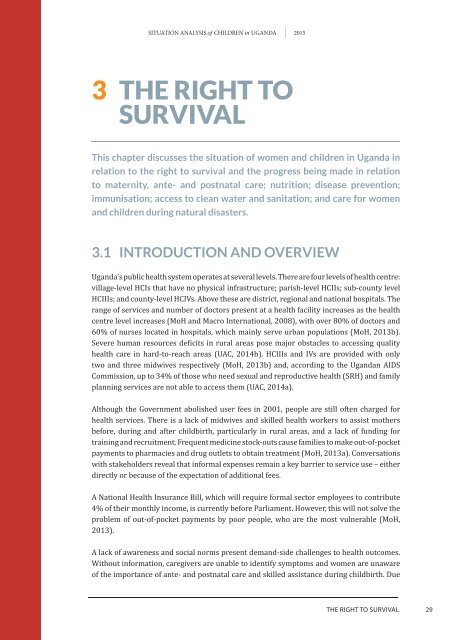Situation analySiS
1TNu802
1TNu802
You also want an ePaper? Increase the reach of your titles
YUMPU automatically turns print PDFs into web optimized ePapers that Google loves.
<strong>Situation</strong> <strong>analySiS</strong> of Children in uganda 20153 the right tosurvivAlThis chapter discusses the situation of women and children in Uganda inrelation to the right to survival and the progress being made in relationto maternity, ante- and postnatal care; nutrition; disease prevention;immunisation; access to clean water and sanitation; and care for womenand children during natural disasters.3.1 INTRODUCTION AND OVERVIEWUganda’s public health system operates at several levels. There are four levels of health centre:village-level HCIs that have no physical infrastructure; parish-level HCIIs; sub-county levelHCIIIs; and county-level HCIVs. Above these are district, regional and national hospitals. Therange of services and number of doctors present at a health facility increases as the healthcentre level increases (MoH and Macro International, 2008), with over 80% of doctors and60% of nurses located in hospitals, which mainly serve urban populations (MoH, 2013b).Severe human resources deficits in rural areas pose major obstacles to accessing qualityhealth care in hard-to-reach areas (UAC, 2014b). HCIIIs and IVs are provided with onlytwo and three midwives respectively (MoH, 2013b) and, according to the Ugandan AIDSCommission, up to 34% of those who need sexual and reproductive health (SRH) and familyplanning services are not able to access them (UAC, 2014a).Although the Government abolished user fees in 2001, people are still often charged forhealth services. There is a lack of midwives and skilled health workers to assist mothersbefore, during and after childbirth, particularly in rural areas, and a lack of funding fortraining and recruitment. Frequent medicine stock-outs cause families to make out-of-pocketpayments to pharmacies and drug outlets to obtain treatment (MoH, 2013a). Conversationswith stakeholders reveal that informal expenses remain a key barrier to service use – eitherdirectly or because of the expectation of additional fees.A National Health Insurance Bill, which will require formal sector employees to contribute4% of their monthly income, is currently before Parliament. However, this will not solve theproblem of out-of-pocket payments by poor people, who are the most vulnerable (MoH,2013).A lack of awareness and social norms present demand-side challenges to health outcomes.Without information, caregivers are unable to identify symptoms and women are unawareof the importance of ante- and postnatal care and skilled assistance during childbirth. DuethE rIGht to SUrvIvaL29




